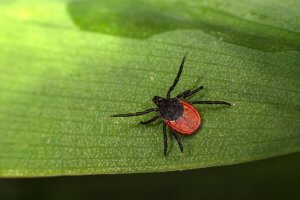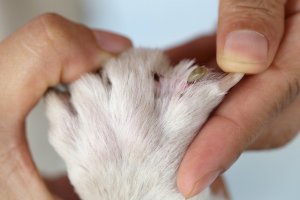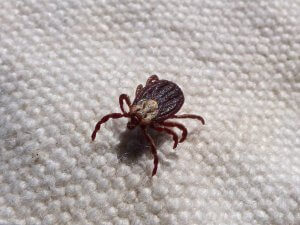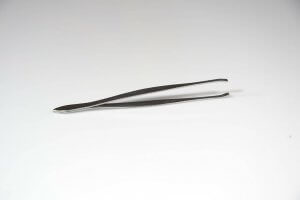How do you thoroughly check for and remove ticks to protect yourself and your family from bites, infestations and tick-borne diseases?
If you’ve been in an area where you might have been exposed to be ticks, immediately follow the following tips —
-
- Check Your Clothing For Ticks
- Inspect Your Body Carefully
- Take A Thorough Shower
- Check Your Pets For Any Ticks
- Use Tweezers To Remove Any Ticks You Discover
Read on to learn more about this pesky little nuisance along with much more thorough details on the 5 key tips, or call Pestco Professional Services for the very best in Pittsburgh tick control! (412) 252-5200

While the joys of warmer weather provide a glorious communion with Mother Nature’s bountiful beauty, this time of year also signals more encounters with some rather nasty little critters seeking nourishment.
Ticks are among them, and they are commonly encountered in tall grass and wooded areas.
According to fossil evidence, ticks have been biting men, women, children and animals for at least 90 million years, dating back to the Cretaceous Period.
There are more than 800 species of ticks throughout the world, but only two families, Ixodidae (hard ticks) and Argasidae (soft ticks), are known to transmit diseases.
Ticks are external parasites that scientifically classified as Arachnids (a classification that includes spiders).
Their body type does resemble those of spiders, albeit they are much smaller, have four pairs of legs as adults and no antennae.
They require blood meals to complete their complex life cycles that include: eggs, larvae, nymphs, and adult male and female stages.
The female adult is the one that bites as males die after mating.
After taking in a blood meal, the tick detaches itself from its host. It then goes on to either find a suitable spot to molt, or another host.
Although ticks prefer moist, humid climes, they area adaptable to many different settings as long as there are hosts such as dog, cats, rodents, birds, deer and humans nearby.

Despite the fact that they live outdoors, they can gain ingress to a home by hitching ride, so to speak, on a pet, your clothing, skin, hair, etc.
If a tick attaches itself to clothing, your clothes, it will make its way toward any uncovered skin.
Ticks prefer warm, moist places on their hosts as well, which include the armpits or groin.
It is not uncommon for home owners who discover ticks in their home to contact the pest-control and pest-maintenance specialists at Pestco for help and advice concerning an infestation.
What Are The Dangers Associated With Ticks?
Scientists have understood that ticks are vectors of disease since the mid 1800’s. With the advent of technology and more advanced tools, the range of the illnesses has become frightening clear.
The microbes present in tick saliva and mouth secretions permeates the skin and blood of the host.
There are a variety of tick-borne diseases accompanied by a wide range of symptoms that usually develop days to weeks after the initial bite.

Symptoms will depend on the particular microbe that is transmitted.
For all tick bites, local cleansing and antibiotic cream may be applied.
A Few Interesting Facts About Ticks
1. Ticks Do Not Jump, Fly, Or Drop
Ticks reach out with their legs and grab or crawl onto a host. Although some larvae have preferred hosts, most ticks in the nymph or adult phases will attach a get a blood meal from several different kinds of mammals, including humans.
2. Hard Ticks And Soft Ticks Feed Differently
Hard ticks are known to attach and feed for hours to days. Disease transmission usually occurs near the end of a meal, as the tick becomes full of blood.
It may take hours before pathogens are transmitted. Soft ticks usually feed for less than one hour but disease transmission can occur in less than a minute.
3. Ticks Are Mini Vampires
Ticks feed on blood and transmit diseases such as Lyme disease, Rocky Mountain Spotted Fever, Ehrlichia and Anaplasma to a variety of hosts such as birds, reptiles, wild and domestic animals and humans.
4. Tick Infestations Are More Common In Dogs Than Cats
Even though cats can and do become victims of tick bites, it occurs more often in dogs because cats are always cleaning themselves.
Tick infestations are also easier to prevent since there are more FDA-approved products to kill ticks on dogs than on cats.
Some tick-prevention products are not safe to use around cats and the pest-control and pest-management experts at Pestco can inform homeowners about which products may work best.
5. Ticks Have Diverse Numbers of Legs At Different Stages of Development
At the larva phase, ticks only have six legs, but they have eight at the nymph and adult stages.
6. Ticks Take Their Time Maturing
It can take up to three years for a tick to reach the adult stage and reproduce.
7. Ticks Are Not Born As Vectors For Disease
They acquire these pathogens while feeding and pass them along to other animals during subsequent feedings.
Many diseases are transmitted only after many hours of feeding, and that time lapse is the reason that most tick prevention strategies employed by highly-trained technicians take place during that time lapse, with the goal of killing ticks before they can transmit disease.
8. Pets And Humans Can Contract Many Diseases From A Single Tick Bite
These diseases can be very serious and even fatal. The tick that your dog carries into the house can bite family members and make everyone sick.
9. Hard Ticks Have A Scutum (Hard Plate) On Their Backs
With this type of tick, the saliva acts like cement, helping to anchor the tick in place and making it harder to remove. The bite of some of these ticks can produce intensely painful reactions.
9. Female Ticks Can Lay Thousands Of Eggs At One Time
Female ticks deposit from 3,000 to 6,000 eggs on the ground, usually inside wood piles, under rocks and inside the cracks and crevices of walls and structures.
After hatching, ticks must feed in order to grow and develop. Females die soon after laying their eggs, and male ticks after mating with one or more females, although some may survive for a few months afterwards.
Ticks can pose a potentially dangerous problem that is often overlooked until it is too late and then there is not recourse but to call the pest-control and pest-management specialists at Pestco for help.
Parasitic worms, viruses, bacteria, spirochetes and rickettsias are a few of the more frequently transmitted organisms to residents of western Pennsylvania.
There are some preventive measures that the average home owner can take to prevent tick bites. They are as follows:
How To Check For And Remove Ticks
Check Your Clothing For Ticks
After being outside, carefully inspect all layers of clothing and gear, Ticks love to hang onto clothing, and gain ingress to homes this way. To kill any ticks found on clothing, put them in a tumble dryer on top heat setting for 10-15 minutes. Warm water will not kill ticks.
Inspect Your Body Carefully
Ticks can be as small as a poppy seed and they love warm, dark places.
Make sure to check between joints (behind the knees, elbows, armpits), behind your ears and anywhere covered in hair.
Take A Shower
This is good practice after returning from a hike and an easy, effective way to wash off any ticks that may have gone unnoticed.
Check Pets
Ticks don’t discriminate, and love to jump onto any mammal that walks by. If you have gone hiking with your dogs, make sure to check that they are tick-free as well.
Removing Ticks
Never remove a tick with a bare hand.
Don’t twist to remove it either. Use tweezers and grasp the tick as close to the skin as possible, apply steady, even pressure and gently pull upward.
It is important not to leave the head embedded in the skin as this can increase the potential rate of infection.
Do not squeeze or grab a tick in the middle of its body as this can cause the tick to spit up any pathogens it may be carrying and spread more toxicity to the host.
Due to the fact that the mouthparts on a tick require several hours to latch themselves deeply into the skin, feeding upon a host cannot occur immediately.
This is why it is so vitally important to remove a tick from the skin as soon as possible.

Get The Very Best In Pittsburgh Tick Control
Ticks are a part of life in Western Pennsylvania.
The most dangerous are the spirochetes, which cause Lyme disease, and rickettsias which are responsible for Rocky Mountain Spotted Fever.
Our experts at Pestco are highly experienced and have been on the pest-control and pest-management landscape since 1948.
We provide any Pittsburgh or Western PA homeowner with superior professional advice and strategies based on prevention, understanding insect behavior and the ability to identify signs of a tick infestation.

Our pro-active pest exclusion services are focused on the selection of appropriate products to implement the process.
These will vary in how well they can withstand pest invaders, and one critical consideration is always the realization that there are no one size-fits-all solutions.
If ticks have infested a space you either own or are thinking of buying, whether it be old or new, before you sit back and relax and that dream becomes a nightmare, call our teams and let us help you with our tried and true, state-of-the-art pest-control and pest-management solutions.
The first step we take in dealing with any pest infestation is to locate its source.
Based on our findings, we will implement a specific treatment plan that will both eliminate the current infestation and prevent future problems.
This process can be very complex and time-consuming, depending on the pest and the severity of the invasion.
Treating tick infestations can be extremely difficult due to the life cycle of the tick in the environment and on the host.
Ticks are always there waiting just for you and your family. Make sure your welcome is one that will insure they never return!
Call our teams today. We’re here to help!
Photo Credits: Pixabay
 Over 300 Reviews
Over 300 Reviews 